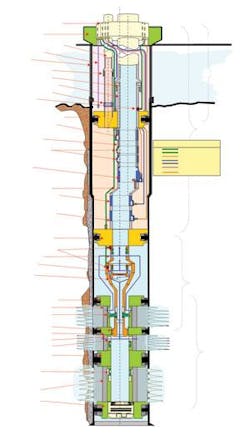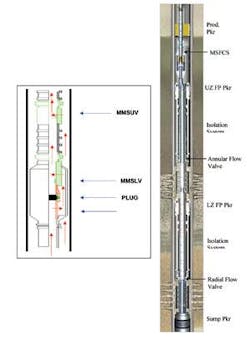Matterhorn TLP succeeds with Pseudo-Smart well completions
Total combines hydraulics with mechanical flow control
Bernard Franklin; BJ Services Co.
Jose Piedras; Total E&P USA Inc.
The Pseudo-Smart system, which Total E&P USA Inc. based on intelligent well technology, aided in the development of the Matterhorn field in the Gulf of Mexico. A complex and challenging completion scenario, which evolved through batch completions, complex well architecture, and deviations to 75°, emphasized the need for design. This design addressed operational issues and contingencies, minimized intervention, and provided reservoir management to maximize production.
Total’s Matterhorn field is in Mississippi Canyon block 243 in 2,811 ft of water. Mississippi Canyon block 243 is 30 mi southeast of the mouth of the Mississippi river and 100 mi southeast of New Orleans, Louisiana. Total batch drilled the wells with a semisubmersible drilling unit prior to the installation of the platform. Due to the shallow nature (approximately 3,500 ft below the mud line) of the upper-targeted sands, the operator kicked off some of the wells about 500 ft below the mud line, resulting in highly deviated wells with a maximum deviation of 72°. The operator then installed a Tri-Star TLP hull and topside with all of the wells tied back to the floating structure. The platform is capable of carrying nine top-tensioned 9 5/8-in., 9 7/8-in., or 10 3/4-in. production risers, seven of which the operator installed on the platform during commissioning.
The main field targets were the Plio-Pleistocene age sands ranging from 3,000 ft-7,500 ft below the mud line. Reservoir pressures range from 3,200-6,700 psi and temperatures from 116-185° F. The reservoirs consist of fine to very fine-grained unconsolidated turbiditic sands. Total developed four reservoirs. The operator completed the main reservoir with four producers and one injector. It completed the other reservoirs with three producers. The reservoir development plan called for an early water injection program, gas lift for all the wells, and real-time monitoring of well pressures, temperatures, and production rates.
Risk
Total mitigated risk created by the application of new technology using history and experience, supplemented with brainstorming sessions and qualification tests. Assessing risk was a major initial and continued consideration during the various phases of the completion.
During the completions phase, the operator considered the following factors to pose the greatest risk:
- Debris management
- Compromising sand control operations and hardware
- Intervention risk during slickline, wireline, coiled tubing, and fishing operations
- Well control while completing a zone
- Isolation of selective intervals during completions of other zones in the wells
- Compromise of well productivity
- Hydrate mitigation.
During the production phase, Total considered the following factors to pose the greatest risk:
- Intervention risk with slick line operations
- Longevity of sand control
- Inability to isolate or selectively flow an interval of choice
- Hydrate mitigation.
Completion strategy
Total had to consider gas, oil producers, and water injectors with different tubing sizes, metallurgy, and reservoir management in its completion design and approach. A workover rig (1,000 hp) with minimal available deck space performed the completion work. The risk associated with a sidetrack or performing a workover on these wells was a key factor in determining the approach taken for the completion design.
The operator developed some elements of the approach based on a fit-for-purpose method and successful experiences from subsea completions with the following forming the basis for design:
- Project design - Allotted seven months for completion phases from concept to reality
- Batch completions - Managed material, availability, logistics, and quality control
- Stacked sand control completions - Involved two or three intervals
- Risk of a workover - Used the MSFCS (Mechanical Smart Flow Control System) in lieu of a hydraulic system or an IWCS to minimize risk
- Effective sand control and evaluation - Applied shunt technology, FP’s, radioactive and chemical tracers, and memory tools for long highly deviated intervals
- Dual completions - Spaced out processes and equipment to set the production packer and pack-off tubing hanger (POTH) and well head in a single trip while conforming the load distribution on the TLP
- Space limitations - Placed spooler, ran and tested dual production string, orientated BOP, and laid out rig floor to accommodate dual trees oriented in four directions
- Different tubing sizes and metallurgies - Used 4 1/2-in., 13% Cr for high rate producers, 3 1/2-in., 13% Cr for the other producers, 4 1/2-in. and 5 1/2-in. carbon steel for injection wells
- Gas lift, flow assurance - Evaluated flow assurance and implemented the use of vacuum insolated tubing (VIT) below the mud line, isolated riser using nitrogen above the mud line, and injected methanol mandrels due to the low BHT’s (98-145˚ F).
Team responsibilities
Minimal timing and the complexity of the project lead to a unique personnel agreement between Total and two major providers - BJ and Schlumberger. The operator company completion team leader and the two major service companies’ project managers formed a centrally located core team to optimize communication and prevent conflict between competing areas. The team broke down the project into activities and produced an organization chart that identified the competencies required to address specific aspects. It serviced the project from several plants and districts in the GoM region, the UK, and France.
The team designed an optimum successful completion, prepared procedures, and provided technical rig supervision for the following operations:
- Conducting well bore cleanup operations
- Installing the lower stacked completion
- Installing the upper single and dual completion
- Installing the dry tree, including surface testing
- Conducting well flow back operations
- Securing the well prior to skidding to the next well.
Quality
As part of the process, Total defined and instituted a quality system (QS) during the initial phase. This encompassed the process of designing, engineering, procuring, assembling and testing, storing, transporting, installing, and consistent reporting. An integral part of the operator’s culture is the people, technology, and quality. Total validated this philosophy and open opportunities to enhance and expand it. Plus, QS became the benchmark for quality and reliability. Total set up many new quality control procedures and methods of testing and implemented them for new designs, such as the MSFCS, packer plugs, etc.
Pseudo-Smart completions design
Total’s completion design had to incorporate simplicity, manufacturing schedules, and a viable economic backup and contingency plan for each of the seven wells. Some of the key objectives and issues that influenced design were:
- Reservoir management - production and injection
- Stacked completions in two or three intervals
- Well deviation
- Minimal post completion intervention
- Zonal real-time pressure and temperature monitoring
- Bi-directional fluid loss control
- Formation damage
- Reduced risk of well control during completion of the other zones and running production
- Debris management
- Casing string size
- Batch completions
- Reliable contingency plans and equipment
- Workover avoidance in a dual completion
- Riser constraints in case of a workover or sidetrack.
Total had five wells with two zones and two wells with three zones that the operator would selectively control from the host platform using a MSFCS. Based on the above-mentioned parameters, the completion design for each well incorporated one of three unique solutions that the operator applied, namely:
- Two zones - Annular flow valve (AFV) and the radial flow valve (RFV)
- Three zones - AFV and mechanical sleeves in two zones
- Three zones - AFV, RFV, and mechanical sleeves
BJ’s interventionless intelligent well completion technology was suitable for three wells on Matterhorn. The lower completion operations consisted of reentry and cleanout of the temporarily abandoned wellbore, tubing-conveyed underbalanced perforating, and sand control operations.
Mechanical smart flow control system
Total’s Matterhorn had seven wells with two or three zones each that the operator had to complete with sand control. The operator and BJ Services Co. initially planned to complete the well as a single with a future workover to access other production intervals. The duo preferred to complete the well as stacked zones to minimize costs and selectively produce these intervals. They applied mechanical intervention to shift sleeves to facilitate selective flow from the zone of choice at high deviations. The team used hydraulically activated devices in conjunction with BJ’s MSFCS without the hydraulics as an alternative to minimize risk and shift the point of manipulation of sleeves up hole.
The companies used multi service valves (MSV) in the lower two zones for selectivity on two wells with three producing sands. The MSFCS was used in these wells based on the production/reservoir plan, whereby the team would deplete one of the bottom two zones and then use the MSFCS for selectivity in conjunction with the upper zone.
Some of the advantages the system offered in lieu of a true interventionless intelligent completion are:
- Synergized with interventionless based technology (AFV and RFV valves)
- Conducted zonal real-time pressure and temperature monitoring
- Reduced risk, which eliminates shifting of sleeves downhole in larger ID’s at shallower depths
- Minimized number of sleeves associated with slick line and coil tubing runs
- Shifted the point of mechanical intervention uphole to a lesser deviated section
- Reservoir management
- Commingled production or injection
- Independent production or injection
- Selective access and zonal isolation
- Simplified in design and application
- Minimized operation expenditures.
This system is analogous to the flow control equipment of an interventionless intelligent system minus the hydraulics. It consists of two proven MSV sleeves. A flow shroud around the lower sleeve (MMSLV) with a plug and perforated pup below the lower valve controls and directs flow from the lower zone into the production tubing. The upper sleeve (MMSUV - unshrouded) controls flow from the upper zone with a flow path similar to a dual completion (casing/tubing annulus). Entry into the upper sleeve and into the production tubing follows. The duo used this system on all wells.
Some of the key lessons Total and BJ learned when using the Pseudo-Smart system in conjunction with intelligent well technology, include:
- Rig and platform visits, both at the dry dock, resulted in subsequent modifications resulting in a smoother operations and saved rig time
- SIT’s onshore prior to shipping eliminated the need and risk to makeup the same on location, thus saving rig time and aided the quality system process in place
- Single trip packer plugs (STPP) could not be used due to gun/reservoir debris and long intervals. The alternative method as outlined in the perforating section worked well
- Conventional perforating steps, including dedicated trips for the packer plug and its removal, are still the most reliable procedure when big size debris free guns are used in long highly deviated intervals
- Post perforation debris cleanup is a serious concern on highly deviated long perforated intervals, and adequate steps must be taken and planned
- Specific packaging for shipping and protection of equipment from the elements plus identification labeling worked well in an offshore environment and saved additional costs
- SL rollers are an inexpensive and simple system, and are an aid in highly deviated wells. Current tractor systems can and will aid slick line operations
- Downhole gauges were of paramount importance during the installation of the production string assembly and production initiation.
Editor’s note: The author presented this paper at the DOT conference on Nov. 30, 2004, in New Orleans, Louisiana.



